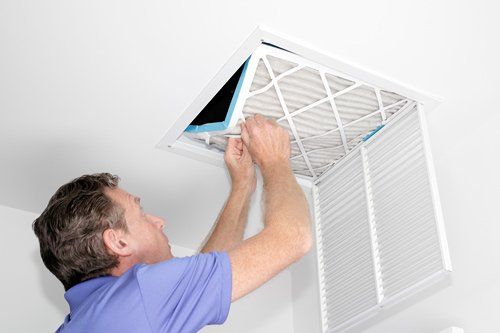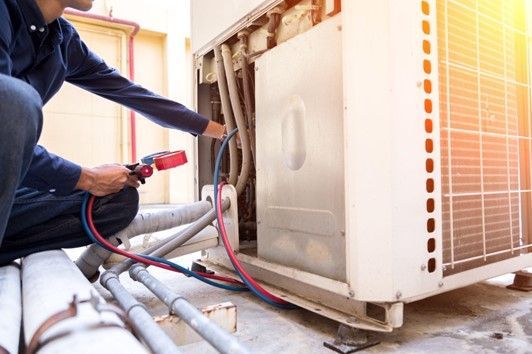Home Renovation and Indoor Air Quality
Admin • January 23, 2019

Your home renovation dreams are about to come true. Along with the new paint, new plaster, and new everything else comes dust, allergens, chemicals, and other possible home remodeling byproducts. Take a look at what you can do to improve your home's indoor air quality during and after a renovation.
Let Air In
Fresh air is an essential part of lowering contamination risks during home renovations. In a closed environment, heating and air conditioning systems can recirculate dust. Opening windows or doors (weather permitting) reduces recirculation, helping to improve the indoor air quality.
Along with improving air circulation, opening doors and windows allows chemical and other smells -such as paint or plaster - out. Proper ventilation is necessary for both your family's and the workers' well-being.
Let Air Out
Even though letting fresh air in is necessary during a home renovation, letting the dust or odor-filled air out is equally important. The contractor should set up and run exhaust fans. These draw pollutants outdoors and away from your home.
Create Barriers
Are you renovating your whole home? If the answer to this question is no, create barriers to prevent dust, dirt, and other debris from going into the rooms you aren't working on. The most obvious, and often easiest, barrier is a door. But gaps in interior doors may allow dust, odors, and other irritants in.
Along with closing doors, cover entry points with ZipWalls (zippered plastic dust barriers). These make it possible for the contractors or your family to get from one room to another while also reducing indoor air pollutant contamination.
While indoor barriers can reduce some of the pollutant risks, they still may allow some dust and construction debris to get in. They also won't stop your air ducts from recirculating dusty air from one room to another.
Clean the Ducts
Cleaning your air ducts mid-remodel won't do much to improve the indoor air quality. Again, letting fresh air in and exhausting polluted air out are the primary methods to use during the renovation. Keeping every window and door open during your home improvement project won't guarantee that the indoor air is dust, allergen, or pollutant-free. The same goes for using exhaust fans.
Indoor air irritants can make their way into your home's ductwork. Cleaning the area following the renovation by wiping down surfaces or vacuuming floors may make your newly remodeled home look pristine. But this doesn't mean the air is clean.
Dirty air that your HVAC system has pulled through into the air ducts will leave behind the remnants of the renovation. These duct-clogging pollutants can reduce the efficiency of your heater or air conditioner and push allergens into your home - especially if you close the windows and turn off the exhaust fans after the work has wrapped up.
The easiest way to reduce the risks of HVAC system indoor air pollution following a renovation is to clean the ducts. Removing thick layers of dust, along with invisible allergens, isn't a job for the average homeowner. Getting deep into the ductwork requires the right equipment and expertise. Instead of trying to DIY clean your ducts, hire a professional to remove what's left over from the renovations.
Replace Filters
After a professional service, your air ducts are clean and dust-free. That is, unless you leave dirty air filters in place. Air filters catch most types of debris before it can enter your home's ductwork. But fine particles, such as those that construction creates, can make their way into your heating or cooling system.
Always replace all air filters following a complete cleaning. This reduces the likelihood of introducing construction debris back into your ducts immediately.
Do you need a professional air duct cleaning? Contact CJ Services Inc
for more information.

Discover the most common HVAC problems and how to prevent them to ensure your system runs efficiently. From dirty filters and clogged drains to faulty thermostats and refrigerant leaks, this guide offers practical tips for maintaining your HVAC system and avoiding costly repairs. Learn how regular maintenance can prolong your system's lifespan and improve performance.
Read our blog to learn about the importance of regular heating system inspections for your home and what to expect during the process.
Window AC units are lifelines during the summertime. Read our blog for usage tips to help you make the most of your AC window unit.
Maintaining clean air ducts in your home is essential for ensuring good indoor air quality. Over time, these ducts can accumulate dust, dirt, mold, and other contaminants that could circulate through your home and affect the air you inhale. Here are six instances when you should consider hiring a professional service to clean your home air ducts. Recent Renovations or Remodeling If your home has recently undergone renovations or remodeling, it's likely that dust and debris have infiltrated your air ducts. Construction activities often generate significant amounts of dust that can settle in ductwork, reducing air quality and potentially damaging your HVAC system. A professional cleaning service will ensure that your air ducts are thoroughly cleaned, preventing any renovation residue from contaminating your indoor air. Noticeable Mold Growth Mold thrives in damp environments, and air ducts can easily become a breeding ground for these harmful spores if moisture is present. If you detect a musty smell or visibly see mold growth around your vents or ductwork, it's crucial to hire a professional to address the issue. Mold in air ducts can exacerbate allergies, asthma, and other respiratory conditions, so timely removal is essential. Increased Allergies or Respiratory Issues If you or someone in your household has experienced an increase in allergies, asthma, or other respiratory problems, dirty air ducts might be the culprit. Contaminants like pollen, pet dander, and dust mites can accumulate and circulate through your home, leading to health issues. A thorough cleaning by professionals can help alleviate these symptoms by removing allergens from your ductwork. Excessive Dust in Your Home Do you often find yourself repeatedly wiping down surfaces, only to find a significant amount of dust gathering in various corners of your home? This could be a sign that your air ducts are clogged with dust and debris. Over time, dust, pet dander, pollen, and other contaminants can build up in your air ducts, circulating back into your living spaces. Professional duct cleaning will not only help improve air quality but also reduce the need for frequent dusting and cleaning around your home. By removing these pollutants, you'll create a healthier environment for you and your family, potentially alleviating allergies and respiratory issues. Rodent or Insect Infestations Air ducts can sometimes become a haven for rodents or insects seeking warmth and shelter. The existence of pests in the ductwork can lead to droppings, nests, and other debris that pose risks to both your health and the efficiency of your HVAC system. These unwelcome intrusions can result in allergens and bacteria spreading, which can compromise the quality of indoor air. Moreover, the buildup of debris may block airflow, causing your HVAC system to operate less efficiently and require more energy, which could lead to increased costs and possible system breakdowns. If you suspect or have confirmed an infestation, it is imperative to call in a professional cleaning service to thoroughly clean and sanitize your ducts. After a Major Illness in the Household If someone in your home has recently suffered from a major illness, cleaning your air ducts can be a proactive step to safeguard the health of the entire household. Airborne bacteria and viruses can linger in ducts and be recirculated, potentially spreading illness. A professional cleaning can help ensure that any lingering pathogens are removed, contributing to a healthier living environment. Hiring a professional service to clean your home air ducts at these critical times can significantly improve your home's air quality, enhance the efficiency of your HVAC system, and promote a healthier living space for you and your family. Regular inspection and maintenance are key to ensuring your ducts remain clean and free from contaminants. If you need your air ducts cleaned out, contact our team at C J Services Inc for more information.
Keeping your commercial building comfortable requires the right AC system. Read our blog to see why ducted AC might be the best choice for you.
When buying a new house, one crucial aspect to not overlook is the air duct system. Explore the process and benefits of a professional air duct inspection.
If you're cleaning up after a house fire, don't forget about your air ducts. Discover six compelling reasons why this is important.
Explore the impact of animal infestations in air ducts and uncover three significant hazards that could lurk behind those innocuous vents.


